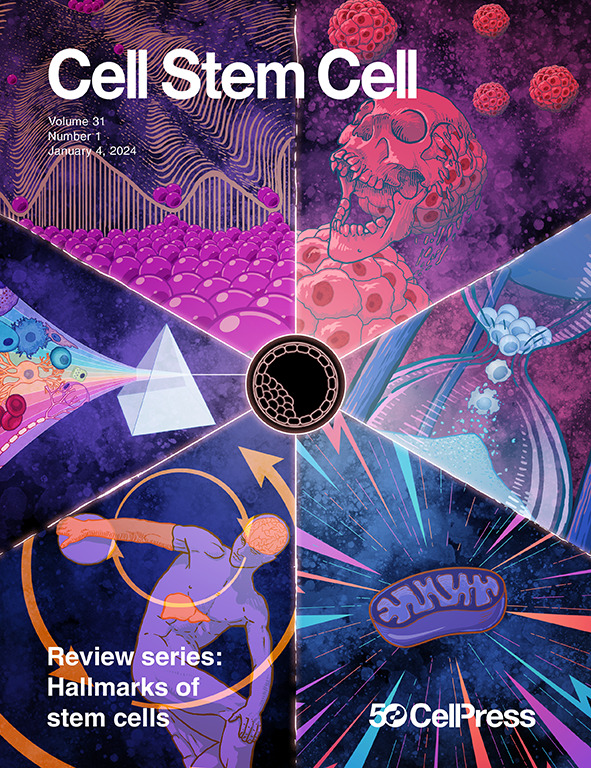A cloaked human stem-cell-derived neural graft capable of functional integration and immune evasion in rodent models
IF 19.8
1区 医学
Q1 CELL & TISSUE ENGINEERING
引用次数: 0
Abstract
Human pluripotent stem cell (hPSC)-derived therapies are a realistic possibility for numerous disorders, including Parkinson’s disease. While generating replacement neurons is achievable, immunosuppressive drug challenges, to prevent rejection, remain. Here we adopted a hPSC line (termed H1-FS-8IM), engineered to overexpress 8 immunomodulatory transgenes, to enable transplant immune evasion. In co-cultures, H1-FS-8IM PSC-derived midbrain neurons evaded rejection by T lymphocytes, natural killer cells, macrophages, and dendritic cells. In humanized mice, allogeneic H1-FS-8IM neural grafts evaded rejection, while control hPSC-derived neural grafts evoked activation of human immune cells, elevated inflammatory cytokines in blood and cerebrospinal fluid, and caused spleen and lymph node enlargement. H1-FS-8IM neural grafts retained functionality, reversing motor deficits in Parkinsonian rats. Additional incorporation of a suicide gene into the H1-FS-8IM hPSC line enabled proliferative cell elimination within grafts. Findings demonstrate feasibility of generating a population-wide applicable, safe, off-the-shelf cell product, suitable for treating diseases for which cell-based therapies are a viable option.

一种在啮齿类动物模型中具有功能整合和免疫逃避能力的隐藏的人类干细胞来源的神经移植物
人类多能干细胞(hPSC)衍生疗法是治疗包括帕金森病在内的许多疾病的现实可能性。虽然产生替代神经元是可以实现的,但免疫抑制药物的挑战,以防止排斥,仍然存在。在这里,我们采用hPSC细胞系(称为H1-FS-8IM),设计过表达8种免疫调节转基因,以实现移植免疫逃避。在共培养中,H1-FS-8IM psc来源的中脑神经元逃避了T淋巴细胞、自然杀伤细胞、巨噬细胞和树突状细胞的排斥反应。在人源化小鼠中,同种异体H1-FS-8IM神经移植物可避免排斥反应,而对照hpsc来源的神经移植物可激活人免疫细胞,升高血液和脑脊液中的炎症因子,并引起脾和淋巴结肿大。H1-FS-8IM神经移植保留了功能,逆转了帕金森大鼠的运动缺陷。在H1-FS-8IM hPSC细胞系中加入自杀基因,可以在移植物中消除增殖细胞。研究结果表明,生产一种适用于所有人群的、安全的、现成的细胞产品是可行的,这种产品适合于治疗基于细胞的疗法是可行选择的疾病。
本文章由计算机程序翻译,如有差异,请以英文原文为准。
求助全文
约1分钟内获得全文
求助全文
来源期刊

Cell stem cell
生物-细胞生物学
CiteScore
37.10
自引率
2.50%
发文量
151
审稿时长
42 days
期刊介绍:
Cell Stem Cell is a comprehensive journal covering the entire spectrum of stem cell biology. It encompasses various topics, including embryonic stem cells, pluripotency, germline stem cells, tissue-specific stem cells, differentiation, epigenetics, genomics, cancer stem cells, stem cell niches, disease models, nuclear transfer technology, bioengineering, drug discovery, in vivo imaging, therapeutic applications, regenerative medicine, clinical insights, research policies, ethical considerations, and technical innovations. The journal welcomes studies from any model system providing insights into stem cell biology, with a focus on human stem cells. It publishes research reports of significant importance, along with review and analysis articles covering diverse aspects of stem cell research.
 求助内容:
求助内容: 应助结果提醒方式:
应助结果提醒方式:


